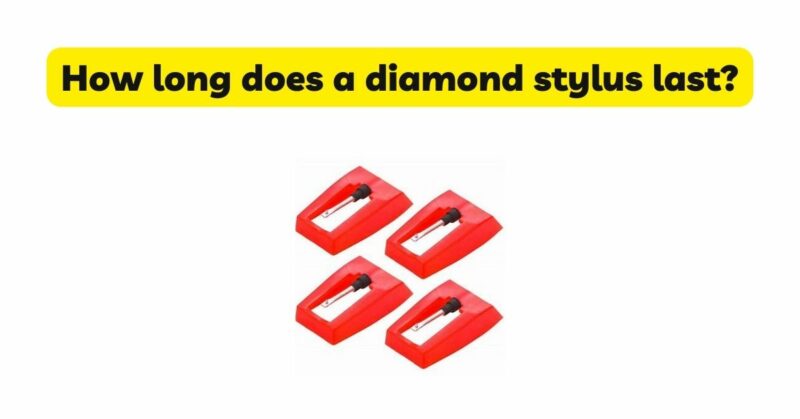Diamond styluses have gained a reputation for their exceptional hardness, durability, and superior sound reproduction capabilities. As with any audio equipment, the lifespan of a diamond stylus is a topic of interest and importance to vinyl enthusiasts. In this article, we will delve into the factors that influence the lifespan of a diamond stylus, examine the expected longevity under various conditions, and provide tips for maximizing its lifespan.
- Understanding Diamond Hardness and Wear Resistance: Diamonds, known as the hardest naturally occurring material, offer unparalleled hardness and wear resistance. These characteristics make diamond styluses capable of withstanding the demands of vinyl playback over an extended period. Unlike other stylus materials such as steel or sapphire, diamond styluses exhibit minimal wear and are designed to provide consistent performance over time.
- Factors Influencing Diamond Stylus Lifespan: Several factors play a significant role in determining the lifespan of a diamond stylus:
a. Usage: The frequency and duration of usage directly impact the stylus lifespan. Heavy and prolonged use, such as DJing or continuous playback, can contribute to increased stylus wear. Conversely, moderate and occasional use will result in a longer lifespan.
b. Record Quality: The condition and quality of the vinyl records played on the stylus affect its longevity. Well-maintained, clean records with minimal defects and damage will reduce the wear on the stylus. Conversely, records with deep scratches, dirt, or debris may cause additional stress on the stylus, potentially reducing its lifespan.
c. Tracking Force: The tracking force, or the pressure applied by the stylus on the record, plays a crucial role in stylus wear. Setting the tracking force within the manufacturer’s recommended range is essential to prevent excessive wear. Too much tracking force can cause premature stylus wear, while insufficient force may lead to tracking errors and compromised sound quality.
d. Alignment and Setup: Proper alignment and setup of the cartridge and stylus are vital for reducing wear. Incorrect alignment can cause uneven wear on the diamond tip, affecting the stylus lifespan and sound quality. Precise alignment minimizes unnecessary stress on the stylus and maximizes its longevity.
e. Record Cleaning: Regular cleaning of records is essential for preserving the stylus. Dust, debris, and particles on the record surface can cause the stylus to skip or become damaged. A clean playing surface reduces the potential for wear and extends the lifespan of the diamond stylus.
- Expected Lifespan: The lifespan of a diamond stylus can vary depending on the aforementioned factors. Generally, a well-maintained diamond stylus can last between 500 to 1000 hours of playback. However, it is crucial to note that this estimate is approximate, and various conditions may impact the actual lifespan.
- Care and Maintenance: Proper care and maintenance play a significant role in maximizing the lifespan of a diamond stylus. Here are some tips to ensure optimal performance and longevity:
a. Cleanliness: Regularly clean both the stylus and the records to remove dust, debris, and contaminants. Use stylus brushes or specially designed cleaning solutions to gently remove any buildup on the stylus tip. Clean records minimize the risk of stylus wear caused by particles in the grooves.
b. Tracking Force: Set the tracking force within the manufacturer’s recommended range. Avoid excessive tracking force, as it can accelerate stylus wear and potentially damage the records. A balanced tracking force ensures optimal performance while minimizing wear.
c. Record Handling: Handle vinyl records with care to prevent unnecessary stress on the stylus. Avoid dropping the tonearm onto the record surface, and always use the cueing mechanism when lowering and lifting the stylus. Mishandling the stylus or records can cause damage and accelerate wear.
d. Alignment: Ensure proper alignment of the cartridge and stylus. Incorrect alignment can lead to uneven wear patterns on the diamond tip, affecting performance and lifespan. Follow manufacturer guidelines or seek professional setup to achieve optimal alignment.
e. Storage: When not in use, protect the stylus by using a stylus guard or keeping the tonearm in its rest position. This prevents accidental damage or contamination of the stylus tip.
- Signs of Wear and Replacement: Regular inspection of the stylus is essential to identify signs of wear and determine when a replacement is necessary. Here are some indicators that a diamond stylus may need replacing:
a. Sound Quality: A noticeable deterioration in sound quality, such as reduced clarity, distortion, or loss of high frequencies, may indicate stylus wear. If the music no longer sounds as crisp and detailed as before, it may be time to consider a replacement.
b. Visual Inspection: Use a magnifying glass or microscope to inspect the stylus tip. Look for signs of wear, such as a flattened or chipped diamond tip. Visible wear on the stylus tip is an indication that it may require replacement.
c. Listening Experience: Pay attention to the overall listening experience. If you find that your stylus is skipping, mistracking, or causing excessive surface noise on records, it could be a sign of stylus wear. In such cases, replacing the stylus may restore optimal performance.
- Upgrading Stylus Technology: Advancements in stylus technology, such as advanced stylus profiles like microline or line contact, can enhance both performance and lifespan. These stylus designs distribute tracking force more evenly, reducing wear and improving sound reproduction. Upgrading to a higher-quality stylus or cartridge assembly can offer benefits in terms of lifespan and overall sound quality.
Conclusion: Diamond styluses are renowned for their exceptional hardness, durability, and superior sound reproduction. With proper care, maintenance, and adherence to recommended tracking forces, a well-maintained diamond stylus can last between 500 to 1000 hours of playback. Factors such as usage, record quality, tracking force, alignment, and record cleaning influence the lifespan of a diamond stylus. Regular inspection and attention to signs of wear will ensure optimal performance and help determine when a replacement is necessary. By following proper care and maintenance practices, vinyl enthusiasts can enjoy the enduring brilliance of a diamond stylus for many hours of immersive listening pleasure.


